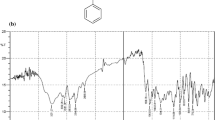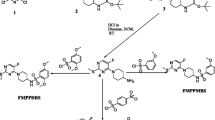Abstract
The corrosion inhibition performance of N-phenylthiourea for mild steel in solutions of 1.0 M hydrochloric and 3.5% wt. sodium chloride was investigated using tandem potentiodynamic polarization curves, scanning electron microscope analysis and quantum chemical calculations. The inhibition efficiency values of N-phenylthiourea in acidic solution and in salt solution were 94.95% and 55.70%, respectively. The results show that the corrosion inhibitor ability of N-phenylthiourea was better than that of urotropine under the same conditions. The adsorption of N-phenylthiourea on the mild steel electrode surface obeys the Langmuir adsorption isotherm in acidic solution and modified Langmuir adsorption isotherm in salt solution. The results of quantum chemical calculations and molecular dynamics simulations were found to be in accord with experimental data.

Corrosion inhibition performance of N-phenylthiourea for mild steel in hydrochloric acid and sodium chloride solution Figure A contains poor quality and small text inside the artwork. Please do not re-use the file that we have rejected or attempt to increase its resolution and re-save. It is originally poor, therefore, increasing the resolution will not solve the quality problem. We suggest that you provide us the original format. We prefer replacement figures containing vector/editable objects rather than embedded images. Preferred file formats are eps, ai, tiff and pdf.Figure A now has been prepared. The font size of text is increased except for the SEM image.













Similar content being viewed by others
References
Al-Amiery AA, Binti Kassim FA, Kadhum AA, Mohamad AB (2016) Synthesis and characterization of a novel eco-friendly corrosion inhibition for mild steel in 1 M hydrochloric acid. Sci Rep 6:19890. https://doi.org/10.1038/srep19890
Al-Amiery AA, Kadhum AAH, Alobaidy AHM, Mohamad AB, Hoon PS (2014) Novel corrosion inhibitor for mild steel in HCl. Mater 7(2):662–672. https://doi.org/10.3390/ma7020662
Deng S, Li X, Xie X (2014) Hydroxymethyl urea and 1,3-bis(hydroxymethyl) urea as corrosion inhibitors for steel in HCl solution. Corros Sci 80:276–289. https://doi.org/10.1016/j.corsci.2013.11.041
Mu G, Li X, Liu G (2005) Synergistic inhibition between tween 60 and NaCl on the corrosion of cold rolled steel in 0.5M sulfuric acid. Corros Sci 47(8):1932–1952. https://doi.org/10.1016/j.corsci.2004.09.020
Agrawal R, Namboodhiri TKG (1990) The inhibition of sulphuric acid corrosion of 410 stainless steel by thioureas. Corros Sci 30(1):37–52. https://doi.org/10.1016/0010-938x(90)90233-u
Cheng XL, Ma HY, Chen SH, Yu R, Chen X, Yao ZM (1998) Corrosion of stainless steels in acid solutions with organic sulfur-containing compounds. Corros Sci 41(2):321–333. https://doi.org/10.1016/s0010-938x(98)00125-5
Frignani A, Monticelli C, Zucchi F, Trabanelli G (2005) Inhibiting action of phenylthiourea towards iron-based metallic glass corrosion in acid environment. Mater Chem Phys 92(2–3):403–407. https://doi.org/10.1016/j.matchemphys.2005.01.037
Özcan M, Dehri İ, Erbil M (2004) Organic Sulphur-containing compounds as corrosion inhibitors for mild steel in acidic media: correlation between inhibition efficiency and chemical structure. Appl Surf Sci 236(1–4):155–164. https://doi.org/10.1016/j.apsusc.2004.04.017
Malinowski S, Jaroszynska-Wolinska J, Herbert T (2017) Theoretical predictions of anti-corrosive properties of THAM and its derivatives. J Mol Model 24(1):1. https://doi.org/10.1007/s00894-017-3528-0
Torres VV, Rayol VA, Magalhães M, Viana GM, Aguiar LCS, Machado SP, Orofino H, D’Elia E (2014) Study of thioureas derivatives synthesized from a green route as corrosion inhibitors for mild steel in HCl solution. Corros Sci 79:108–118. https://doi.org/10.1016/j.corsci.2013.10.032
Yan Y, Li W, Cai L, Hou B (2008) Electrochemical and quantum chemical study of purines as corrosion inhibitors for mild steel in 1M HCl solution. Electrochim Acta 53:5953–5960. https://doi.org/10.1016/j.electacta.2008.03.065
Fouda AE-AE-S, Hussein A (2012) Role of some phenylthiourea derivatives as corrosion inhibitors for carbon steel in HCl solution. J Korean Chem Soc 56(2):264–273. https://doi.org/10.5012/jkcs.2012.56.2.264
Richardson LB (1917) The adsorption of carbon dioxide and ammonia by charcoal. J Am Chem Soc 39(9):1828–1848. https://doi.org/10.1021/ja02254a005
Zhao T, Mu G (1999) The adsorption and corrosion inhibition of anion surfactants on aluminium surface in hydrochloric acid. Corros Sci 41(10):1937–1944. https://doi.org/10.1016/S0010-938X(99)00029-3
Behpour M, Ghoreishi SM, Soltani N, Salavati-Niasari M, Hamadanian M, Gandomi A (2008) Electrochemical and theoretical investigation on the corrosion inhibition of mild steel by thiosalicylaldehyde derivatives in hydrochloric acid solution. Corros Sci 50(8):2172–2181. https://doi.org/10.1016/j.corsci.2008.06.020
Frisch M, Trucks G, Schlegel H, Scuseria G, Robb M, Cheeseman J, Scalmani G, Barone V, Mennucci B, Petersson G (2009) Gaussian 09, revision D. 01. Gaussian, Inc, Wallingford, CT
Janak JF (1978) Proof that ∂E/∂ni=ε in density-functional theory. Phys Rev B 18(12):7165–7168. https://doi.org/10.1103/PhysRevB.18.7165
Pearson RG (1987) Recent advances in the concept of hard and soft acids and bases. J Chem Edu 64(7):561. https://doi.org/10.1021/ed064p561
Pearson RG (1988) Absolute electronegativity and hardness: application to inorganic chemistry. Inorg Chem 27(4):734–740. https://doi.org/10.1021/ic00277a030
Parr RG, Yang W (1984) Density functional approach to the frontier-electron theory of chemical reactivity. J Am Chem Soc 106(14):4049–4050. https://doi.org/10.1021/ja00326a036
Lu T, Chen F (2012) Multiwfn: a multifunctional wavefunction analyzer. J Comput Chem 33(5):580–592. https://doi.org/10.1002/jcc.22885
BIOVIA DS (2017) Materials studio, Revision 6.0. Accelrys, San Diego, CA http://www.3dsbiovia.com/
Elfaydy M, HL RS, Larouj M, Jodeh S, Rbaa M, Oudda H, Toumiat K, Lakhrissi B (2016) Investigation of corrosion inhibition mechanism of Quinoline derivative on mild steel in 1.0 M HCl solution: experimental, theoretical and Monte Carlo simulation. J Mater Environ Sci 7:3193–3210
Kumari M (2017) Use of hexamine as corrosion inhibitor for carbon steel in hydrochloric acid. Int J Adv Educ Res 2(6):224–235
Oguzie EE (2005) Inhibition of acid corrosion of mild steel by Telfaria occidentalis extract. Pigm Resin Technol 34(6):321–326. https://doi.org/10.1108/03699420510630336
Robert J, Chin KN (1971) Electrochemical characteristics of iron in H2SO4 containing benzotriazole. J. Electrochem Soc 118(4):545
Bayol E, Kayakırılmaz K, Erbil M (2007) The inhibitive effect of hexamethylenetetramine on the acid corrosion of steel. Mater Chem Phys 104(1):74–82. https://doi.org/10.1016/j.matchemphys.2007.02.073
Brolo AG, Temperini MLA, Agostinho SML (1992) Effect of hexamethylenetetramine as a corrosion inhibitor for copper in bromide medium. J Electroanal Chem 335(1–2):83–92. https://doi.org/10.1016/0022-0728(92)80234-u
Hosseini M, Mertens SFL, Arshadi MR (2003) Synergism and antagonism in mild steel corrosion inhibition by sodium dodecylbenzenesulphonate and hexamethylenetetramine. Corros Sci 45(7):1473–1489. https://doi.org/10.1016/s0010-938x(02)00246-9
Singh DDN, Singh TB, Gaur B (1995) The role of metal cations in improving the inhibitive performance of hexamine on the corrosion of steel in hydrochloric acid solution. Corros Sci 37(6):1005–1019. https://doi.org/10.1016/0010-938x(95)00010-h
Sherif E-SM (2006) Effects of 2-amino-5-(ethylthio)-1,3,4-thiadiazole on copper corrosion as a corrosion inhibitor in 3% NaCl solutions. Appl Surf Sci 252(24):8615–8623. https://doi.org/10.1016/j.apsusc.2005.11.082
McCafferty E (2010) Introduction to corrosion science. https://doi.org/10.1007/978-1-4419-0455-3_12
Lebrini M, Lagrenée M, Vezin H, Traisnel M, Bentiss F (2007) Experimental and theoretical study for corrosion inhibition of mild steel in normal hydrochloric acid solution by some new macrocyclic polyether compounds. Corros Sci 49(5):2254–2269. https://doi.org/10.1016/j.corsci.2006.10.029
Moretti G, Quartarone G, Tassan A, Zlngales A (1996) 5-amino- and 5-chloro-indole as mild steel corrosion inhibitors in 1 N sulphuric acid. Electrochim Acta 41(13):1971–1980. https://doi.org/10.1016/0013-4686(95)00485-8
Redlich O, Peterson DL (1959) A useful adsorption isotherm. J Phys Chem 63(6):1024–1024. https://doi.org/10.1021/j150576a611
Foo KY, Hameed BH (2010) Insights into the modeling of adsorption isotherm systems. Chem Eng J 156(1):2–10. https://doi.org/10.1016/j.cej.2009.09.013
Temkin MaP V (1940) Kinetics of Ammonia synthesis on promoted Iron catalysts. Acta Physicochim URSS 12:217–222
Ali SA, Saeed MT, Rahman SU (2003) The isoxazolidines: a new class of corrosion inhibitors of mild steel in acidic medium. Corros Sci 45(2):253–266. https://doi.org/10.1016/S0010-938X(02)00099-9
Cheng S, Chen S, Liu T, Chang X, Yin Y (2007) Carboxymenthylchitosan as an ecofriendly inhibitor for mild steel in 1 M HCl. Mater Lett 61(14):3276–3280. https://doi.org/10.1016/j.matlet.2006.11.102
Larabi L, Benali O, Harek Y (2006) Corrosion inhibition of copper in 1 M HNO3 solution by N-phenyl oxalic Dihydrazide and oxalic N-phenylhydrazide N′-phenylthiosemicarbazide. Port Electrochim Acta 24:337–346
Patel NS, Jauhari S, Mehta GN (2009) Inhibitor for the corrosion of mild steel in H2SO4. S Afr J Chem 62:200–204
Bereket G, Yurt A, Türk H (2003) Inhibition of the corrosion of low carbon steel in acidic solution by selected polyelectrolytes and polymers. Anti-Corros Method M 50(6):422–435. https://doi.org/10.1108/00035590310501585
Zarrok H, Assouag M, Zarrouk A, Oudda H, Hallaoui A, Touzani R, Allali M, Hammouti B, El Hezzat M, Bouachrine M (2015) Quantum chemical study on the corrosion inhibition of some bipyrazoles. Res J Pharm Biol Chem Sci 6:1853–1860
Gece G (2008) The use of quantum chemical methods in corrosion inhibitor studies. Corros Sci 50(11):2981–2992. https://doi.org/10.1016/j.corsci.2008.08.043
Obot IB, Macdonald DD, Gasem ZM (2015) Density functional theory (DFT) as a powerful tool for designing new organic corrosion inhibitors. Part 1: an overview. Corros Sci 99:1–30. https://doi.org/10.1016/j.corsci.2015.01.037
Camacho-Mendoza RL, Gutierrez-Moreno E, Guzman-Percastegui E, Aquino-Torres E, Cruz-Borbolla J, Rodriguez-Avila JA, Alvarado-Rodriguez JG, Olvera-Neria O, Thangarasu P, Medina-Franco JL (2015) Density functional theory and electrochemical studies: structure-efficiency relationship on corrosion inhibition. J Chem Inf Model 55(11):2391–2402. https://doi.org/10.1021/acs.jcim.5b00385
Guo L, Ren X, Zhou Y, Xu S, Gong Y, Zhang S (2017) Theoretical evaluation of the corrosion inhibition performance of 1,3-thiazole and its amino derivatives. Arab J Chem 10(1):121–130. https://doi.org/10.1016/j.arabjc.2015.01.005
Khalil N (2003) Quantum chemical approach of corrosion inhibition. Electrochim Acta 48(18):2635–2640. https://doi.org/10.1016/s0013-4686(03)00307-4
Ebenso EE, Isabirye DA, Eddy NO (2010) Adsorption and quantum chemical studies on the inhibition potentials of some thiosemicarbazides for the corrosion of mild steel in acidic medium. Int J Mol Sci 11(6):2473–2498. https://doi.org/10.3390/ijms11062473
Parr RG, Pearson RG (1983) Absolute hardness: companion parameter to absolute electronegativity. J Am Chem Soc 105(26):7512–7516. https://doi.org/10.1021/ja00364a005
Ibrahim T, Gomes E, Obot IB, Khamis M, Abou Zour M (2016) Corrosion inhibition of mild steel by Calotropis procera leaves extract in a CO2 saturated sodium chloride solution. J Adhes Sci Technol 30(23):2523–2543. https://doi.org/10.1080/01694243.2016.1185229
Issa RM, Awad MK, Atlam FM (2008) Quantum chemical studies on the inhibition of corrosion of copper surface by substituted uracils. Appl Surf Sci 255(5):2433–2441. https://doi.org/10.1016/j.apsusc.2008.07.155
Mann CA, Lauer BE, Hultin CT (1936) Organic inhibitors of corrosion aromatic amines. Ind Eng Chem Res 28(9):1048–1051. https://doi.org/10.1021/ie50321a018
Yilmaz N, Fitoz A, Ergun Ü, Emregül KC (2016) A combined electrochemical and theoretical study into the effect of 2-((thiazole-2-ylimino)methyl)phenol as a corrosion inhibitor for mild steel in a highly acidic environment. Corros Sci 111:110–120. https://doi.org/10.1016/j.corsci.2016.05.002
Yamamoto Y, Nishihara H, Aramaki K (1992) Inhibition mechanism of sodium 3-n-octylmercaptopropionate for iron corrosion in 0.5 M NaCl solution. Corros 48(8):641–648. https://doi.org/10.5006/1.3315984
McCafferty E (2010) Corrosion inhibitors. In: McCafferty E (ed) Introduction to corrosion science. Springer, Berlin, pp 357–402. https://doi.org/10.1007/978-1-4419-0455-3_12
Zhou X, Yang H, Wang F (2011) [BMIM]BF4 ionic liquids as effective inhibitor for carbon steel in alkaline chloride solution. Electrochim Acta 56(11):4268–4275. https://doi.org/10.1016/j.electacta.2011.01.081
Acknowledgments
This research is funded by Viet Nam National Science and Technology Development (NAFOSTED) under grant number 104.06-2016.03. We also thank Nguyen Minh Thong, University of Danang, Campus in Kontum, Vietnam for the calculations of Fukui functions.
Author information
Authors and Affiliations
Corresponding author
Additional information
Publisher’s note
Springer Nature remains neutral with regard to jurisdictional claims in published maps and institutional affiliations.
Electronic supplementary material
ESM 1
(DOCX 25 kb)
Rights and permissions
About this article
Cite this article
Huong, D.Q., Duong, T. & Nam, P.C. Experimental and theoretical study of corrosion inhibition performance of N-phenylthiourea for mild steel in hydrochloric acid and sodium chloride solution. J Mol Model 25, 204 (2019). https://doi.org/10.1007/s00894-019-4084-6
Received:
Accepted:
Published:
DOI: https://doi.org/10.1007/s00894-019-4084-6




